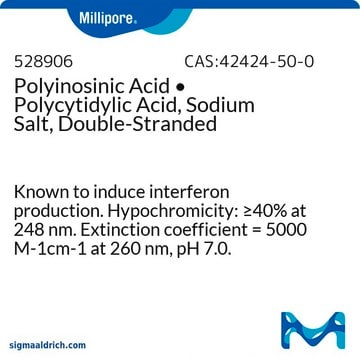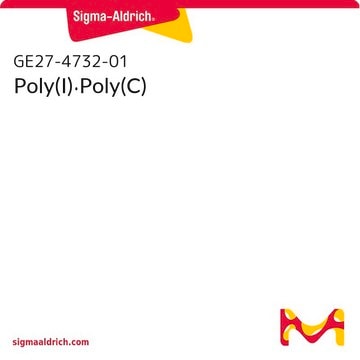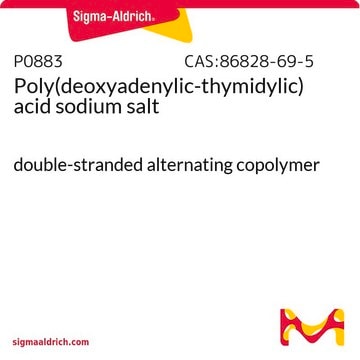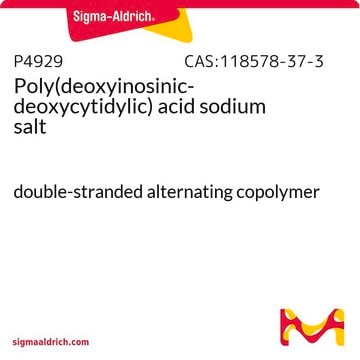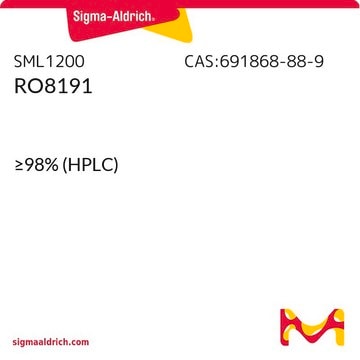The long term stability of this product in solution is not been investigated. However, aqueous solutions are expected to be stable for at least 6 months when stored in working aliquots at -20°C. Please see the link below to review the product datasheet for additional information:
https://www.sigmaaldrich.com/deepweb/assets/sigmaaldrich/product/documents/143/182/p9582pis.pdf
P9582
Polyinosinic–polycytidylic acid potassium salt
with buffer salts, TLR ligand tested
Sinonimo/i:
Poly (I:C), Poly(I) • Poly(C)
Scegli un formato
Scegli un formato
About This Item
Prodotti consigliati
Livello qualitativo
Saggio
≥99% (less than 1% free nucleotides, TLC)
Stato
lyophilized powder
Composizione
Poly(I) • Poly(C), 10% (balance buffer salts as sodium chloride and sodium phosphate)
Condizioni di stoccaggio
desiccated
Temperatura di conservazione
−20°C
Cerchi prodotti simili? Visita Guida al confronto tra prodotti
Applicazioni
Azioni biochim/fisiol
Confezionamento
Altre note
Nota sulla preparazione
Codice della classe di stoccaggio
11 - Combustible Solids
Classe di pericolosità dell'acqua (WGK)
WGK 3
Punto d’infiammabilità (°F)
Not applicable
Punto d’infiammabilità (°C)
Not applicable
Dispositivi di protezione individuale
Eyeshields, Gloves, type N95 (US)
Scegli una delle versioni più recenti:
Certificati d'analisi (COA)
Non trovi la versione di tuo interesse?
Se hai bisogno di una versione specifica, puoi cercare il certificato tramite il numero di lotto.
Possiedi già questo prodotto?
I documenti relativi ai prodotti acquistati recentemente sono disponibili nell’Archivio dei documenti.
I clienti hanno visto anche
-
What is the stability of this product in solution? For example, how long would a 5 mg/mL solution last when stored at -20 celcius?
1 answer-
Helpful?
-
-
What is the size (bp) of this product?
1 answer-
This product has a estimated size range of 272 - 4242 bases with a resulting molecular weight range of 90,000 - 1,400,000 daltons.
Helpful?
-
-
Does the product P9582-5MG contain 5mg of polyI:C or 500ug (10%) of poly I:C and 4.9mg buffer salts?
1 answer-
This product contains 10% Poly (I:C) with sodium chloride and sodium phosphate buffer salts. Please see the link below to a sample Certificate of Analysis for further details regarding concentration of the Poly (I:C).
https://www.sigmaaldrich.com/certificates/sapfs/PROD/sap/certificate_pdfs/COFA/Q14/P9582-50MG0000213739.pdfHelpful?
-
-
What is the Department of Transportation shipping information for this product?
1 answer-
Transportation information can be found in Section 14 of the product's (M)SDS.To access the shipping information for this material, use the link on the product detail page for the product.
Helpful?
-
-
How stable is Product P9582, Polyinosinic-polycytidylic acid potassium salt, in solution?
1 answer-
RNA and synthetic RNA analogues will be very stable in aqueous solution as long as the solutions are not contaminated with RNase.
Helpful?
-
-
What is the molecular weight of Product P9582, Polyinosinic-polycytidylic acid potassium salt?
1 answer-
The molecular weight may vary from lot to lot with a range from 90,000 to 1,400,000 with an average of 200,000 to 500,000.
Helpful?
-
-
Why is the total mass of Product P9582, Polyinosinic-polycytidylic acid potassium salt, in my bottle much greater than the designated package size?
1 answer-
The package size is based on the polynucleotide content. However, since the polynucleotide is supplied with sodium chloride and sodium phosphate buffer salts, its mass represented by the package size is approximately 10% of the total mass present in the bottle.
Helpful?
-
-
Should Polyinosinic-polycytidylic acid potassium salt Product P9582 or P1038 be used for cell activation?
1 answer-
For cell activation, synthetic double-stranded RNA is widely used as ligand of Toll-like receptor 3 (TLR3) in place of what is supposed to be the natural ligand (viral dsRNA). The double stranded RNA homopolymer, i.e. Poly(I):Poly(C), Prod. No. P9582 can be used for this application. P1038 is a single-stranded RNA and will not activate TLR3.
Helpful?
-
-
What is the difference between Polyinosinic-polycytidylic acid potassium salt Products P9582, P1038, P1530 and P0913?
1 answer-
Prod No. P9582 as well as Prod. Nos. P1530 and P0913 are double-stranded with one strand of Poly(I) and one strand of Poly(C). Prod. No. P1038 is a single-stranded RNA analog with C and I randomly making up the polynucelotide strand. Double-stranded Prod. No. P9582 is a potassium salt while double-stranded Prod. Nos. P0913 and P1038 are sodium salts. Prod. No. P0913 is gamma-irradiated. None of the other products have been gamma-irradiated. Unlike the other products, only approximately 10% of the total mass of Prod. No. P9582 is actually polynucleotide. The remaining 90% is buffer salts as sodium chloride and sodium phosphate.
Helpful?
-
Active Filters
Il team dei nostri ricercatori vanta grande esperienza in tutte le aree della ricerca quali Life Science, scienza dei materiali, sintesi chimica, cromatografia, discipline analitiche, ecc..
Contatta l'Assistenza Tecnica.
